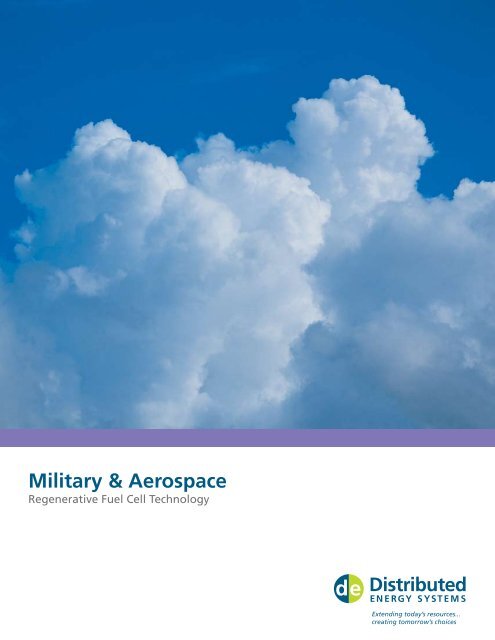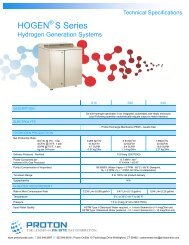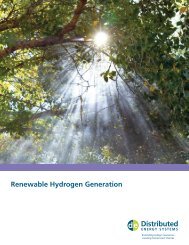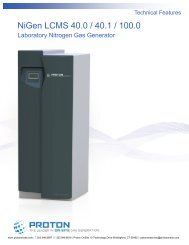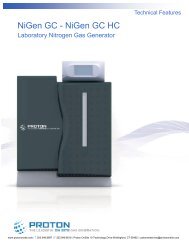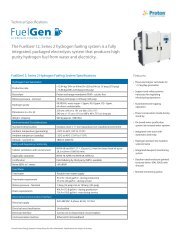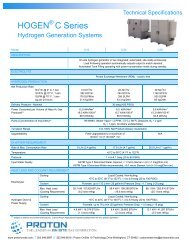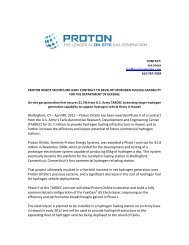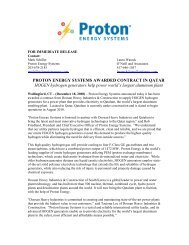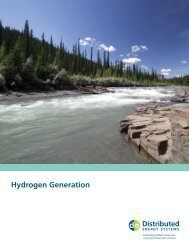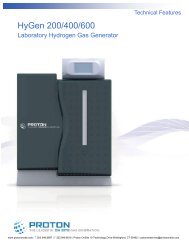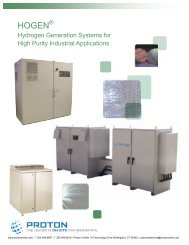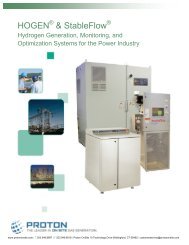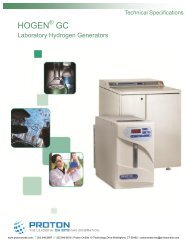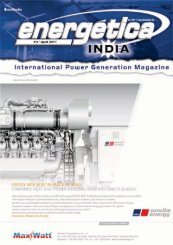Military & Aerospace - Proton OnSite
Military & Aerospace - Proton OnSite
Military & Aerospace - Proton OnSite
Create successful ePaper yourself
Turn your PDF publications into a flip-book with our unique Google optimized e-Paper software.
<strong>Military</strong> & <strong>Aerospace</strong><br />
Regenerative Fuel Cell Technology<br />
de<br />
Distributed<br />
EN E RGY S YST E M S<br />
Extending today’s resources...<br />
creating tomorrow’s choices
Regenerative Fuel Cells<br />
The <strong>Military</strong> & <strong>Aerospace</strong> Team within the Technology Generation group designs,<br />
develops, models and builds technology solutions based on our core proton<br />
exchange membrane (PEM) technology. We meet the technical needs of a diverse<br />
customer base that includes civilian and military government agencies and<br />
commercial aerospace partners.<br />
The primary needs that Distributed Energy Systems fulfills for our customers are supplying lightweight energy<br />
storage systems, hydrogen gas for fuel, or oxygen gas for breathing or as an oxidizing agent. We meet these needs<br />
by applying our high pressure water-electrolysis cells and high specific energy Regenerative Fuel Cell (RFC) energy<br />
storage systems. An RFC decouples energy storage from energy conversion, which frees the RFC from the size and<br />
weight penalties of batteries. We have capability with Unitized and Discrete RFC energy storage systems to optimize<br />
mass, volume, and roundtrip efficiency for a variety of mission scenarios.<br />
Regenerative Fuel Cell System Features & Benefits<br />
• Air-independent operation<br />
• Compatible with energy harvesting (solar, wind, wave)<br />
• Low signature<br />
• Enables long duration missions<br />
• Enables persistent surveillance<br />
• Enables loitering capability<br />
• Enables long-term data collection for earth science missions<br />
Regenerative Fuel Cell System<br />
How does it work?<br />
A closed-loop RFC is a critical energy<br />
storage system when ambient oxygen<br />
is not available. Both hydrogen<br />
and oxygen are generated by the<br />
electrolyzer and stored. A special fuel<br />
cell capable of 100% utilization of the<br />
hydrogen and oxygen consumes the<br />
reactants and generates DC electricity<br />
and product water.
Features & Benefits<br />
Application Specific Features & Benefits<br />
Satellites<br />
• Integrated energy storage and propulsion system using gaseous<br />
hydrogen and oxygen<br />
• Easily refuelable spacecraft with only low pressure water<br />
Electrolysis<br />
Stack<br />
Hydrogen<br />
High altitude aircraft<br />
• High specific energy (400-1000 Wh/kg), 2-5 times higher than advanced<br />
batteries, when configured with lightweight composite pressure vessels<br />
Unmanned undersea vehicles<br />
• High volume energy density when configured with metal hydride storage<br />
• Dry-connection recharge<br />
• No surfacing, no snorkeling<br />
Logistics fuel<br />
• Turns water, an existing logistics stream, into hydrogen fuel for vehicles,<br />
primary and backup power systems<br />
• Generated from renewable resources such as solar, wind and wave energy<br />
Oxygen<br />
Fuel Cell<br />
Stack<br />
Water<br />
An RFC, combined with metal<br />
hydride hydrogen storage and<br />
high pressure oxygen storage,<br />
is a competitive energy storage<br />
system for underwater vehicles.<br />
A concept design for a 21-inch<br />
diameter unmanned underwater<br />
vehicle can achieve faster recharge<br />
than the best batteries.<br />
Other applications<br />
• Generation of oxygen and/or hydrogen in the absence of air<br />
Case Study<br />
High Altitude Airship Project<br />
The Missile Defense Agency is currently supporting the development of a<br />
stratospheric airship long-endurance unmanned aerial vehicle (UAV). The<br />
mission of the High Altitude Airship program is to provide a multi-purpose<br />
platform to support homeland defense, deployable communications for<br />
regional conflicts, special operations, and joint theater operations. RFC<br />
technology enables the long endurance capability, as batteries are just too<br />
heavy. The airship would operate its payload and simultaneously recharge<br />
the reactant storage tanks on power provided by a photovoltaic array<br />
during daylight hours. Through the night hours, the stored reactants will<br />
be fed to a fuel cell to power the payload. Such a system can remain in<br />
flight, on station 24-hours per day for months or years at a time.<br />
Illustration courtesy of Missile Defense Agency
Contact us<br />
Corporate Headquarters<br />
Hydrogen Generation | Technology Generation<br />
10 Technology Drive<br />
Wallingford, CT 06492<br />
Tel: +01.203.678.2000<br />
Power Generation<br />
29 Pitman Road<br />
Barre, VT 05641<br />
Tel: +01.802.461.2955<br />
Visit us online at<br />
www.distributed-energy.com<br />
NASDAQ: DESC<br />
de<br />
Distributed<br />
EN E RGY S YST E M S<br />
© 2007 Distributed Energy Systems Corp, All Rights Reserved<br />
PD-0600-0036 04.07<br />
.<br />
Extending today’s resources...<br />
creating tomorrow’s choices


